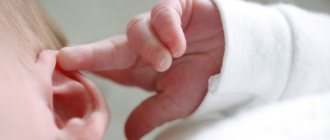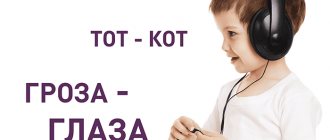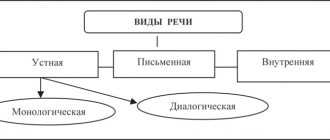FORMATION OF SPEECH SKILLS OF PRE-SCHOOL CHILDREN IN A PRE-SCHOOL CONDITION
Kuimova Elena Evgenievna
teacher of MBDOU "Kindergarten No. 9" "Fairy Tale" of the city of Lesosibirsk
FORMATION OF SPEECH SKILLS OF PRE-SCHOOL CHILDREN IN A PRE-SCHOOL CONDITION
In the Federal State Educational Standard, preschool education is highlighted as one of the educational areas - “Speech development”. Speech is the basis for the development of all other types of children's activities: communication, cognition, cognitive research. In this regard, the development of speech of a young child becomes one of the pressing problems in the activities of a preschool teacher.
Speech development is one of the important areas in working with preschool children. The Law “On Education in the Russian Federation” identifies the main guidelines for updating the content of education within a preschool institution. It provides guidance on the personal identity of each child, on the development of each person’s abilities, broadening the child’s horizons, transforming the subject environment, ensuring children’s independent and joint activities in accordance with their desires and inclinations.
The most complete and methodologically successful definition of speech activity was proposed by the famous Russian scientist-psycholinguist, prof. I. A. Winter. “Speech activity is a process of active, purposeful, language-mediated and situation-conditioned interaction between people.
In the psychological dictionary, “skill” is defined as an intermediate stage of mastering a new way of activity based on knowledge, but has not yet reached the level of skill or automation. Skill is the ability to perform a certain action or activity productively, selecting and applying appropriate techniques.
In our study, we consider the concept of “skill” as the ability of a preschooler to carry out speech activity at a high level consciously, which will be associated with the creation of something new.
Most pedagogical research proves that older preschoolers have unique capabilities in the field of speech development; they are able to come up with original fairy tales orally under the influence and as a result of special training.
Preschool age is the initial stage of the formation of a child’s personality, the formation of his personal qualities. In the studies of T. S. Komarova, N. A. Vetlugina, A. N. Poddyakov, V. V. Davydov and others, devoted to the development of artistic and creative abilities of preschool children, it is noted that when a child is created motivation for creativity, personality traits appear , characterizing him as a creator. Among them, the authors highlight: curiosity, creative initiative, artistic and creative activity, independence, passion for the process of creative activity, focus, empathy, the need for cooperation in creative activity.
At the same time, researchers claim that they reach a certain level of development only at the end of senior preschool age. In this regard, in our opinion, personal qualities are not included in the structure of the ability to compose fairy tales in older preschool children, but develop along with it.
In pedagogy, there is a classification of methods according to the source of knowledge: visual, verbal and practical. We believe that the most effective of them for the formation of speech skills of preschoolers will be the following: observation; with the help of observation, the child sees a specific picture of the interaction of interesting facts that reflect life in natural conditions for him. Excursions based on clarity, a mandatory combination of showing and telling, and motor activity, i.e., the movement of tourists along a specific route in order to study objects at their location and during the movement itself.
Descriptions of pictures and toys are aimed at accumulating the content of speech, and are also used to consolidate vocabulary, develop the generalizing function of words, and teach coherent speech. The advantage of using pictures is that they help to gradually overcome errors in the construction of sentences. A very interesting technique, in my opinion, is drawing. It can be used to compose pictures, thereby developing the speech of a preschooler . There is also such a technique as an unfinished drawing, which is indispensable for the development of creative abilities, both in drawing and in the development of speech . Unfinished figures can be turned into anything: a spaceship, mountains, plants, inhabitants of the planet, astronauts, etc. Then the teacher, together with the child, examines the drawing and discusses the result. The game method of teaching helps to create an interested, relaxed atmosphere and establish a psychologically age-appropriate communication situation.
We believe that the most effective methods for developing speech skills are visual methods (observation), or its variation (excursion), since they are aimed at accumulating the content of speech and provide communication between two signal systems, since with the help of these methods it seems possible to achieve high results in the formation of speech skills of preschool children.
Types of speech
There are two main types of coherent speech:
- Monologue.
- Dialogical.
The first requires great communication skills. How correctly a thought is expressed depends on how others will understand it. The narrator is required to have a good memory, correct use of speech patterns, and developed logical thinking so that the narrative sounds consistent and clear.
During dialogue, complex verbal expressions are usually not used. Speech does not have a clear logical sequence. The direction of the conversation can change arbitrarily and in any direction.
Components of speech
Speech can be divided into two components: situational and contextual. When expressing his thoughts or describing a situation, a person must construct a monologue so that the listener understands what the conversation is about. At first, children are unable to describe the situation without specifying specific actions. It is difficult for an adult, listening to a story, to understand what the conversation is about without knowing the situation. Thus, situational coherent speech of preschoolers is formed first. At the same time, the presence of a contextual component cannot be completely excluded, since such moments of speech are always interconnected.
Bookmark speech skills
The formation of coherent speech occurs in several stages.
Stage 1 – preparatory, from 0 to 1 year. At this stage, the baby becomes familiar with sounds. During his first weeks, he simply listens to adult speech, while a passive set of sounds is formed in him, and he makes his first cries. Later, babble appears, which consists of randomly pronounced sounds.
During the same period, the child is shown objects and the sounds that characterize them are called. For example: clock - tick-tock, water - drip-drip. Later, the baby reacts to the name of the object and looks for it. By the end of the first year, the baby pronounces individual syllables.
Stage 2 – pre-school, from one to three years. First, the child pronounces simple words denoting both an object and an action. For example, with the word “give” a baby means an object, his desires, and a request, which is why only close people understand it. After a certain period, simple sentences appear, the child begins to express his thoughts more accurately. By the age of three, prepositions are used in speech. The coordination of cases and gender begins.
Stage 3 – preschool, from 3 to 7 years. This is a period of more conscious personality formation. Closer to 7 years, the speech apparatus is formed, the sounds are clear and correct. The child begins to construct sentences competently, he already has a vocabulary that is constantly expanding.
Stage 4 - school, from 7 to 17 years old. The main feature of speech development at this stage compared to the previous one is its conscious assimilation. Children master sound analysis and learn grammatical rules for constructing statements. The leading role here belongs to written speech.
These stages do not have strict, clear boundaries. Each of them smoothly transitions into the next.
Contextual speech
Having mastered the situational component, the child begins to master the contextual one. At first, children’s spoken language is full of pronouns “he,” “she,” and “they.” At the same time, it is not clear who exactly they refer to. To characterize objects, the concept “such” is used and is actively supplemented by gestures: with your hands you show what it is, for example, big, small. The peculiarity of such speech is that it expresses more than it expresses.
Gradually, the child begins to build a speech context. This becomes noticeable when a large number of pronouns disappear from the conversation and are replaced with nouns. Coherent speech is determined by the consistency of a person’s thoughts.
You cannot master coherence without having logic. After all, speech directly depends on thoughts. Coherent speech is the sequence and logic of thoughts expressed out loud and combined into grammatically correct sentences.
From the child’s conversation, it is clear how developed his logic is and what kind of vocabulary he has. If there is a lack of words, even a logically correctly constructed thought will cause difficulties in speaking out loud. Therefore, speech must be developed in a complex way: logic, memory, rich vocabulary. Everything should be harmonious.
Development of coherent speech in preschoolers
After starting kindergarten, the child’s environment changes and, along with it, the form of speech. Since until the age of 3, a child is constantly close to people close to him, all communication is based on his requests to adults. There is a dialogical form of speech: adults ask questions, and the child answers. Later, the baby has a desire to tell about something, to convey his feelings after a walk, and the listeners can no longer be only close people. This is how the monologue form of speech begins to take shape.
All speech is coherent. However, the forms of connectivity change with development. Coherent speech presented by a child is the ability to tell in such a way that what is heard becomes understandable on the basis of its own content.
Methods of coherent speech - mnemonics
The technique is based on the use of pictures. All stories and poems are encoded with pictures, which are then used to tell the story. The method is based on the fact that children in preschool age rely more on visual memory than on auditory memory. Training occurs with the help of mnemonic tracks, mnemonic tables and model diagrams.
The symbols with which words are encoded are as close as possible to the speech material. For example, when talking about domestic animals, a house is drawn next to the animals depicted, and a forest is drawn for wild animals.
The study goes from simple to complex. Children look at mnemonic squares, and later at mnemonic tracks with depicted symbols, the meaning of which they know. The work is carried out in stages:
- Studying the table.
- Encoding information, transforming the presented material from symbols into images.
- Retelling.
With the help of mnemonics, children acquire speech intuitively. At the same time, they develop a good vocabulary and the ability to conduct a monologue coherently.
Main types of formation of coherent speech
The development of coherent speech in children occurs using various techniques. The main ones:
- Development of dialogue skills.
- Retelling.
- A story based on pictures.
- Writing descriptive stories.
The first type of conversation that a child masters is dialogue. Children are taught:
- Listen and understand the speech of an adult.
- Communicate with other children.
- Build a dialogue by answering questions.
- Repeat words and phrases after the teacher.
Children aged 4-7 years are taught simple forms of constructing a monologue.
Retelling requires attentiveness and perseverance from the child. First, there is preparation for the retelling, then the teacher reads the text, and after that the children answer questions related to the material they read. A retelling plan is drawn up, then the teacher reads the story again, and the retelling begins. Children of primary preschool age do almost everything together with the teacher. Older children themselves develop a retelling plan. Thus, they maintain the connection between logic and speech.
Consultations for parents in kindergarten on speech development
The educational work carried out by teachers is an important, but not the only aspect on which the success of a child’s speech development depends. The family rightfully plays a decisive role in shaping the child’s speech behavior. It is important to unite the efforts of teachers and parents, timely consultations and joint solutions to problems.
Parents and teachers have at their disposal a universal tool for both the primary and subsequent speech development of children: folklore.
Folklore as a means of speech development for preschool children
Oral folk art helps to master rich, figurative, logically structured speech.
Round dances, tongue twisters, proverbs and sayings, nursery rhymes, riddles, epics, lullabies, fairy tales - all this is not only possible, but should be used in interaction with the child by both parents and teachers.
It is important to understand! Folklore expands vocabulary, increases the level of coherence, develops imagination and logic.







